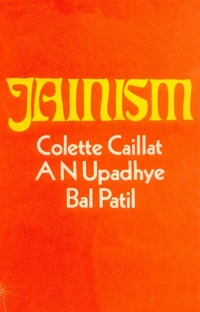Around the Prophet, around the Law which he preaches, congregates the religious Community or samgha. Quadripartite, it comprises the ascetics, monks and nuns and the faithful laity, men and women, who render possible the spiritual life of the former, and who listen to their teaching. Hence their names of upasaka ‘servant’ and of sravaka, ‘listener’. According to the text, the epochs and diverse circumstances, the ascetic is called nirgrantha (literally ‘unbound’ by the attachments of the world), bhiksu ‘mendicant’ sadhu (“just, saint”), etc.
Religious life is that which leads to liberation (which, however, is impossible to women, according to the Digambara beliefs). It is forbidden to the one who is not free and wholesome of body and spirit, to the children less than seven and a half years old. At the moment of quitting the world the faithfully renounces all his property. An ascetic gives him the monastic equipment, a gesture which signifies, in some sort, the going out of the world. He performs a novitiate course under the orders of a spiritual leader to whom he owes total obeisance. Is head is shaved, and his hair is periodically cut, shaved or pulled out. After four months on an average, fifty vows in the course of consecration (diksa, upasthapana) which makes him a genuine member of the religious community and which sets him as a monk.
From that moment he forms, with his fellow-members, more or less comprehensive groupings under the orders of masters who supervise his material and spiritual welfare. At all the stages the hierarchy is very minutely articulated, scrupulously respected. The names of certain dignitaries have been mentioned previously, the Sthavira’ ‘doyen’, the suri, a Svetambara title, relatively late. The chiefs of the gana, company, are the ganins; the preceptor, charged with literary teaching, is the upadhyaya, whereas the mater par excellence, the pastor who dispenses the profound instruction and guides the faithful in the practice of the Doctrine is called acarya (two titles alike in usage in the Brahmanic and the Buddhist religious community).
The companies of the nuns have their proper superior, who on the other hand, however elevated their grade may be, are under the authority of the religious masters. Moreover the separation of the sexes is strict, except in cases of danger, when the monks and nuns are directed to help each other.
As a result of the fifty monastic vows, the monks possess absolutely nothing. But because of piety, or in order not to give offence, the employ a certain number of objects which constitute their monastic equipment. It comprises of a ‘robe’ or rather piece of cloth (three for the novices, four for the nuns), which it is forbidden to darn and wash: one (sometimes two) bowl for alms which is made of a gourd or of wood, or of clay; a sort of short broom with which the monk can carefully sweep clean the place before himself so that he will not hurt any minute animal; finally, a small piece of muslin (originally reserved, it appears, to ward off dust and insects from the face). The text mention diverse sorts of sticks, the length of which is regulated, and which vary according to the season, etc. (1)* There are differences in equipments according to sets, sub-sects and regions.
Following the example of Mahavira, the monks lead an itinerant life, do not dwell, on principle, more than one to five days (maximum a month) in the same locality. But during the four months of monsoon they remain sedentary. The habitation is chosen according to minutes rules: it is necessary to take care that neither the host nor the household occupy the place at the disposal of the monks who, besides, must not accept alms of nourishment from any member of the family who lodges them. Little by little, ‘shelters’ (upasrayas) have been built and reserved to permit the sojourn of the monks.
Their time table is strictly regulated. The day and night are divided in four equal parts (paurusi) each of which is reserved for a fixed work: study, meditation, eventually change of place, and at the third paurusi, in day-time, alms begging, at night, sleep.
Concerning instruction and its methods, gradation of the texts, etc., the directives are precise. Even the novice must necessarily know certain formulae which constitute the six ‘obligations’ (avasyaka): general vows, to be recollected several times in the day, hymns to the twenty-four Trithamkaras, formula of address to superior, formula of confession, formula announcing the meditation, formula for refusing the nourishment.
The rules which have reference to the search of alms, and above all the search of nourishment are extremely delicate and numerous. It is particularly enjoined to avoid the consumption of the least particle of life and recommended not to hurt any minute creature. One eats indeed only during the day so as to check the nutrients better. The two meals of the day are often reduced by reason of the multiple fasts, the nature, the duration, and even the arrangement of which imparts many variations. At the limit, the Jain whether ascetic or follower, who unto death: this is the only suicide which has religious value- and even a very meritorious suicide (naturally, and only if, the believer acts with an absolute detachment). Besides, the texts recommend certain ascetic postures to the monks(but not to the nuns).
All are directed to confess their least errors, with full and entire sincerity, to their superiors upon whom falls the duty to judge them. They atone afterwards their errors by adequate penitences the amount of which is calculated is with minute precision. It appears that certain faults have entailed partial or total retrogressions.
Finally, all the monks are very closely bound up with all the other members of their religious community: it gives them occasion incessantly to practise all forms of mutual aid.
Besides, the ascetics dispense their spiritual support to the faithful laity, who in return aid them by their important material contribution.
The liberality, impossible to the monk who possesses nothing, is recommended to the householders. They spend generously in favour of the poor, among whom are included the old and sick animals whom they group, as one knows, in special places.
Since the middle age, the lay community has devoted a great part of its riches to the edification, maintenance and restoration of the temples.
It has been seen that many temples have been constructed on the initiative of leading and illustrious members of the community. Historic vicissitudes have caused the devastation and ruin of certain sanctuaries the tones of which have sometimes been re-employed for raising other structures, as in the case of the mosques, at Delhi, Cambay, etc.
But a great number of them are still extant whether in Karnataka or in northern Indian. Some are relatively isolated (as at Belgaum), the others on the contrary are grouped, as in the little village of Mudabidri in the environs of Mangalore. The most numerous, the richest and the most concentrated are in Rajputana, towards Udaipur and at Dilwara (Mount Abu), also in Gujarat, whether in towns (Patan, Ahmedabad, Cambay),or on sites outside the agglomeration: on the mountain of Girnar, and still more on the hills of Satrunjaya, where they throng between 850 and 900.
It is the duty of the laity to supervise the maintenance and improvement of the temples, whose cleaning and embellishment is entrusted to officiating ministers the pujaris, who often are not Jains.(1) In the South, they are as a rule, Jains. Some of them are called Jain-Brahmans, i.e. Jain-priests. It does not behove the monks to celebrate the cult nor even to participate therein, especially as numerous minute creatures perish in the course of these rites which the Hindu practices have strongly influenced, but which have appeared necessary to fortify the faith of the laity.
The faithful brings to the temple various offerings, flowers, fruit (coconuts, almonds, bananas) and grains of rice which he places on tablets in small piles with which he draws auspicious symbolic figures. The officiating priest proceeds to wash and anoint the images to Trithamkaras, to whom eight principal types of offerings are presented: water, sandalwood, flowers, incense, lamps (which one balances before them), sugar, fruits etc. The faithful indicate their devotion by moving the fan before the icons, by resounding the bells. The worship is exists, by the recitation of the ancient formulae of meditation and of mantras, syllables and formulae to whom is attributed a magical power- for the Jains, like other Indians, believe in the supernatural power of certain arrangement of phonemes and letters. (2) These have regional differences.
The devotion is not directed only to the Jinas (who theoretically, do not intervene in our
World), but also to the couple of genies who flank them: the yaksa and above all the yaksini (who has replaced the ancient srutadevata).
 Bal Patil
Bal Patil
 Prof Dr. Colette Caillat
Prof Dr. Colette Caillat
 Prof. Dr. Adinath Neminath Upadhye
Prof. Dr. Adinath Neminath Upadhye
